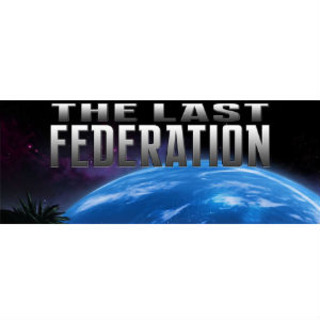INTRO:
When one thinks of a bullet hell shooter, one would think about planning routes around incoming fire while utilizing reflexes in order to maximize damage output while minimizing damage taken. When one thinks of a 4X-lite, one would think about fast-paced empire-building gameplay. It would be rare for such thoughts to overlap.
Yet overlap they would in Arcen Games’ The Last Federation. Arcen Games has been around for a while, creating surprisingly dense (though not necessarily very complex) games, so it is not entirely a surprise that they have made yet another surprising game. (Pardon the tautology.)
Anyway, The Last Federation will be testing the player’s ability to plan, not just to dodge storms of firepower while eliminating swathes of enemies, but to nurture empires too, albeit not of the player’s own.
PREMISE:
The player character is the last member of its species – a species of sentient but cruel giant multi-headed space-faring serpents. This species, called the Hydrals, is one of several in a surprisingly life-rich cluster of planets. Thanks to their incredible longevity, the Hydrals were able to achieve the level of technology that is needed to travel the stars.
Unfortunately, ever since then, they had suppressed the technological advancement of any other species that they can reach, apparently through vile and violent means. Needless to say, they were much hated by the other species, who could do little against them.
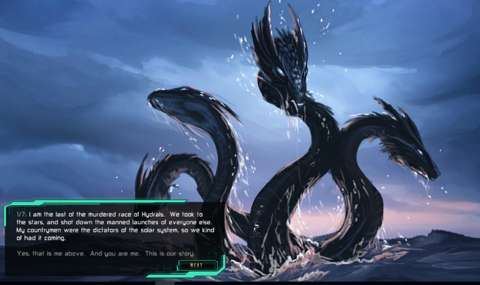
However, the player character is a Hydral who realizes that its species had been appallingly awful. It decided that for its race to make amends, it has to be exterminated. Somehow, it has managed to manipulate the technological advancement of the other species without being discovered. Eventually, the protagonist’s scheme comes to terrible fruition; the Hydrals did not foresee one of their own moons crashing into their home planet while all of them – bar one – were on it.
On the other hand, the player character has not revealed its schemes, preferring to be captured and incarcerated by one of the other species, while seemingly helping the latter develop an incredibly powerful ship that would grant them supremacy.
Of course, this was one more of its schemes. After having escaped with the ship, it started its next plan – to unite the cluster of planets under a ‘federation’ in order to achieve lasting peace, by whatever means necessary.
The story is of course wildly absurd science-fiction bull-honkey that was concocted to furnish the gameplay with a narrative.
THE GOAL:
The main goal of every playthrough is to make sure that every species either joins the federation that the player character would found, or is eliminated. Even if just one species remains to form a federation, the player wins.
It might seem that getting all species on board would seem harder than getting just a few, but the truth is that achieving any permutation of species in the federation in the endgame is a great challenge because of how they interact with and balance each other.
MYRIAD OF SPECIES IN A REGION TOO SMALL:
As mentioned earlier, the player character’s species and other species (called “races” in-game, but “species” is a more technically correct term) live in the same cluster of planets and share the same star. It is incredible how every planet in the cluster is conducive to life, but that is of course just sci-fi tripe.
Anyway, there are several species, all of which will be present in every playthrough. All species have a few common traits, such as needing to live on planets to survive, but these traits are very few. Each species has its own idiosyncrasies which are actually significant to gameplay, as will be described later.
As expected, these species do not get along well with each other, at least initially. Most of them will not think twice about wiping out another species if they believe that their own species can benefit greatly from the demise of another.
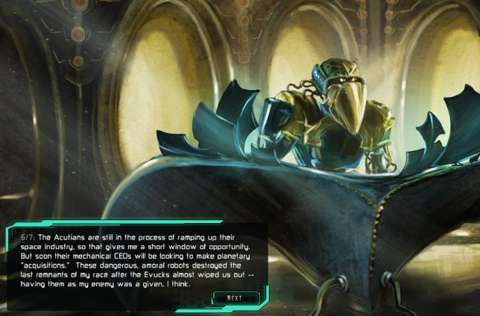
THE PLANETARY SYSTEM:
There are only as many planets as there are species. In other words, each planet in the star system is the homeworld of one species.
This means that as soon as one species conquers another planet for the first time in a playthrough, one other species would be eliminated. Therefore, if the player is aiming for a victory with all species still alive, he/she will want to prevent any species from conquering another planet; this will be particularly challenging if this species is the Burlust or the Thoraxians, both of whom are rather aggressive.
In addition to the planets, there is the empty void in between them. This will eventually be filled up with space stations, which may belong to the various species or the player character, if the player has managed to score these valuable assets.
Otherwise, in the vanilla version of the game, there are not a lot of spatial bodies to be seen in the system map view.
PLAYER CHARACTER’S SHIP:
As mentioned earlier, the player character has a one-of-a-kind super-ship. Its model depends on the species which has captured the last Hydral. The different models have similar performance in combat, despite looking different.
However, some models do have ever-active abilities which do not require the player to manually enable them. For example, the model which the last Hydral develops while in the custody of the Andorians has point-defense capabilities which allow it to shoot down some, but not all, incoming projectiles. These advantages come with the cost of load-outs that are smaller in size than the models which do not have ever-active abilities.
Anyhow, the player character’s ship is a power-house that can wreck enemies; this is of course to be expected of the player character in a bullet-hell shooter. However, in contrast to the player ships in bullet-hell shooters, the Hydral’s ship is very, very tough. Even on the most severe difficulty (which stacks considerable statistical penalties on the player character’s capabilities), the player will have to either deliberately let the ship be destroyed or make a terribly stupid tactical blunder in order to lose.
Speaking of the ship’s durability, it is represented with two virtually independent meters: its hull and its shields. Shields are very much what a follower of space science fiction would expect; they block damage that would otherwise be inflicted on the hull of the ship. After the shields have been depleted, the ship will start to take hull damage.
Shields can recharge, but hull damage cannot be reversed. In other words, the player might want to be careful about controlling the ship’s exposure to enemy fire.
However, there are ordnances which ignore shields. These ordnances tend to be slow and have considerable visual contrast to munitions which do not penetrate shields. For example, there are torpedoes which go through shields to inflict heavy damage on the hull.
The other capabilities of the ship will be described in their own sections, because they have more impact on gameplay than shields and hull points.
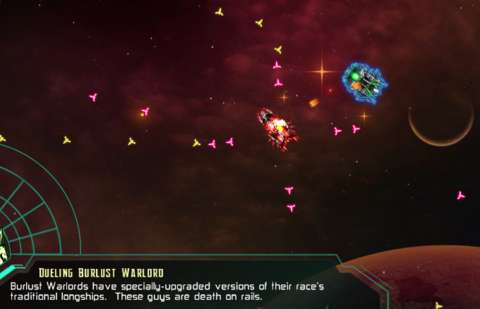
TURNS:
The proceedings of combat are presented in terms of “turns”. These “turns” are not like the turns in turn-based games (e.g. players, human or otherwise, taking turns while the others await theirs). Rather, they are more like periods of time. Before each period of time, or “turn”, as the game would call it, the player can decide on what the ship would do in that period of time.
This is the extent of the control that the player has over the ship; there is nothing that the player could do but watch the consequences of his/her decisions unfold during that period of time.
This part of the gameplay removes reflexes as a factor in the player’s performance, which is perhaps where the game diverges from actual bullet hell shooters. This is for the better, because it rewards the player’s skill at planning, and punishes the player’s failure at anticipating danger.
POWER DISTRIBUTION IN SHIP:
One of the key elements of combat is the control of the distribution of power to three aspects of the ship. The aspects are the Weapons, Shields and Engines. The Weapons aspect controls the range and damage of the ship’s guns, the Shields aspect determines how fast shields recharge and the Engines aspect determines how fast the ship can accelerate.
Distributing power among the aspects will be a key part of battle. For example, if the player really needs something to be knocked out as soon as possible, it would be wise to pour power into Weapons. If the player needs to get the ship out of trouble, taking power out of Weapons and into Engines will be useful for escapes. After reaching a relatively clear spot, the player can bring up Shields to recharge the ship’s shields faster.
To facilitate this, the player can take units of power out of the aspects and place them in a separate counter. These power units are useless as long as they are not allocated, but it makes for easier re-distribution of power than the default method of raising one aspect while simultaneously reducing one other.
Interestingly, the game will automatically re-distribute the power if it notices that the player is doing the same thing over a couple of turns and that there is a power distribution combination that is conducive to this. For example, if the player intends to have the ship stay in a spot for a while, power will be automatically distributed to Shields and Weapons from Engines.
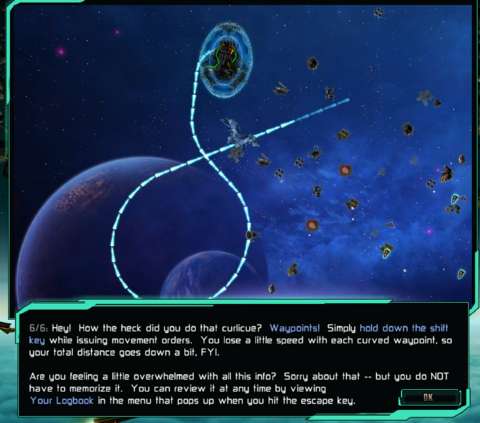
MOVEMENT IN COMBAT:
In combat, the Hydral’s ship is practically one of the fastest ships around. Most other ships are slow and sluggish compared to it; in fact, it can fly circles around them. Indeed, flying around them is a good tactic, if only to avoid their forward-firing weapons. There are enemy ships which are far faster, such as those which protect pirate freighters, but they are rarely encountered outside of specific missions. (These ships happen to resemble Star Wars’ Millennium Falcon, by the way.)
By directing more power into Engines, the ship’s acceleration – not its speed – increases. With full power to Engines, the ship can move across an incredible distance in just a turn. However, the Engines aspect does not appear to control deceleration. Rather, the player’s ship has to bleed off speed over the course of several turns, depending on how fast it already was and if the player is making more movement inputs. For example, turning the ship will cause it to lose speed.
Speaking of movement inputs, these can be a bit much for player’s who are not already experienced in gameplay that is about projected motion. Fortunately, there are visual indicators which show how much distance the player’s ship would actually move, versus the distance which the player wants it to move. The former considers the ship’s momentum, so the player will have to manipulate the latter in order to have the ship move exactly according to the distance and direction which the player wants.
This can be a tad unwieldy, but it does emphasize the importance of the ship’s momentum.
SHOOTING:
Conveniently, the Hydral’s ship has weapons which can track any target along any direction, as long as it is within range. In other words, the player does not have to aim at all.
That does not mean that the weapons on the player’s ship would automatically hit enemies; they can miss their intended targets. However, their projectiles move so quickly such that they are likely to hit their targets anyway – unless the targets happen to be vessels which are far faster than the Hydral’s ship.
As mentioned earlier, diverting more power to the Weapons aspect increases the damage output of guns and their range. The latter is particularly important, because the player will want to be able to hit enemies while trying to keep out of their range.
Before the start of the next turn, the player has to choose a weapon to use and its firing behavior. By default, the firing behavior is set to “automatic”, which has the chosen weapon firing at enemies which are most vulnerable to it. Alternatively, the player could have the ship specifically focus its firepower on a single target, if it is within range during the turn. The player could also have the ship hold its fire, but there is usually no reason to do so.
In the vanilla version of the game, the guns which can be used would seem all too familiar to a veteran of sci-fi games, especially shoot-‘em-ups. There is the rapid-fire weapon which is best used on a target that still has its shields, another rapid-fire weapon which is used on a target that has lost its shields, a weapon which fires out in a cone from the ship and an energy beam that hits anything in its path, among other guns.
In the vanilla version of the game, there does not appear to be any reason to use anything other than the Minigun and the Energy Blaster. These two rapid-fire weapons have more-than-decent accuracy and projectile speed, thus making them the most effective weapons to use while remaining on the move. The other weapons would have been more useful if there are a lot of soft targets clustered together, but the Minigun and Energy Blaster get the job done all the same anyway.
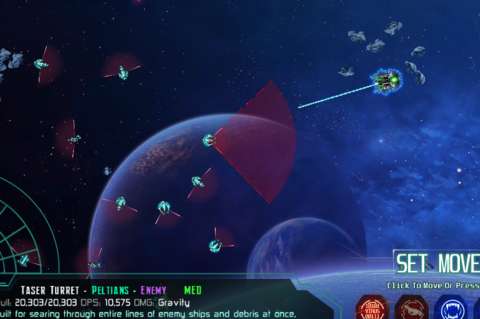
ABILITIES:
In addition to shooting and moving about, the player’s ship also has cooldown-based capabilities. This is nothing new, because auxiliary powers for the player character have been around in a lot of video games.
There is something that makes these abilities stand apart from those in other video games, however. This is their secondary effect, which is common to virtually all of them. Whenever an ability is triggered, a shockwave emanates from the player’s ship, obliterating any incoming projectiles. (This will seem familiar to people who have played Legend of Jamestown and have experienced that game’s Vaunt system.)
This shockwave is important, because in order to use an ability, the player’s ship cannot do anything else but stay in place.
As for the primary effects of these abilities, they are intended to temporarily relieve some of the pressure on the player. For example, there are abilities which cloak the player’s ship, thus preventing it from being targeted; the cloak however cannot block any already-incoming fire.
As another example, there are abilities which somehow summon allied ships to the player’s side. They cannot be controlled in any way, however, thus limiting their usefulness to just being ablative shields or distractions.
These abilities do not just run on cooldowns; they also have limited uses. Fortunately, an exhausted ability will be replaced with another, though the player has only limited control over which ability replaces the exhausted one.
Speaking of control, the player can choose the order in which replacement abilities appear. This is convenient, but it would have been better if the player can manually pick abilities to fit the current situation.
ENEMIES & ALLIES:
In most battles, the Hydral ship is on its own and just about everything else is hostile to it. As mentioned earlier, most enemies are slow and can barely do much of anything against the Hydral ship on their own. However, there are many of them, and they can certainly fill the screen with projectiles.
Most enemies are ships, meaning that they will move about, usually towards the player’s ship. Most of their weapons cannot penetrate the Hydral ship’s shields, but some can, like the aforementioned torpedoes.
There are also enemies which are static defenses. Since they are immobile, they are generally easier to deal with than mobile enemies. However, they compensate for their disadvantage with rather high damage potential.
There are also static defenses which can only fire in a single direction; these compensate by having considerably more range and damage. Furthermore, these defenses will continuously fire as long as the player’s ship is within a certain range of them. In other words, they serve the role of area denial.
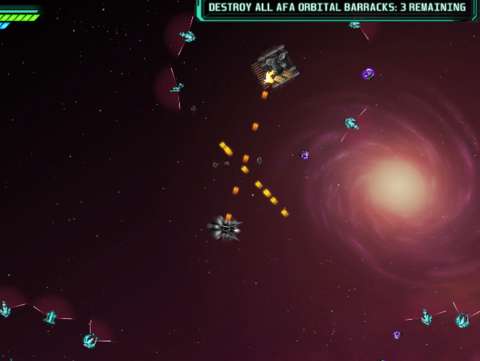
Some ships can spawn smaller ships during battle; they can continue to do so as long as they remain in combat. This means that the player risks being swamped by a torrent of small ships. Although the small ships seemingly cannot do much against the player’s ship on their own, they will still chip away at the player’s ship.
There are also bosses and certain other special enemies which will be described later, together with the scenarios which they are associated with.
THE RACES – GAMEPLAY OVERVIEW:
The game refers to the different species as “races”, so this review article will refer to them as such – mainly because “race” is quicker to write than “species”.
Anyway, as mentioned earlier, the planetary system has several races which do not necessarily like each other. The races require planets to survive; although each race starts with one as its homeworld, some races have expansionist tendencies, with an eye especially for planets which are suitable for their races (more on this later). Some of them just do not like each other, and some go to war as easily as they breathe (assuming that they breathe of course).
Therefore, it is inevitable that hostilities will break out. When this happens, the opportunistic races will also go to war as well, often targeting the weakest of the races. This can spiral out of control. More importantly, the warring races will hate each other, making the effort to get them to form a federation all the more difficult. However, war also provides opportunities to curry favor with the races; this will be described further later.
Anyway, the player’s main goal is to form a federation of planets, with at least one race in it. Having all of them in the federation is a challenge, but this is not necessarily the toughest of challenges. In fact, getting any permutation of races to survive is a similarly difficult challenge, mainly due to the specific designs of each race. These will be described later in their own sections.
Generally, each race projects its hard power in two ways: navies and ground forces. Navies are more common than the other, because there are more targets that can be attacked with navies than there are targets which are attacked with ground forces. (The latter kind of targets are of course planets.)
As for their soft-power, i.e. their ability to influence the other races, it varies tremendously from race to race. Their soft-power is also a gameplay factor which the player has considerable control over, as will be described later.
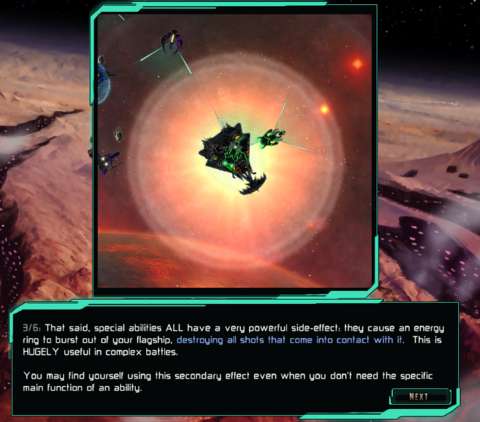
Speaking of the player’s control, the player will need to earn what the game terms as “Influence” over them; this includes the aforementioned favors. This usually means doing something that they like, even if it might seem detrimental to them (or other races). The player will be juggling Influences a lot, because an endeavor which a race likes is likely to upset some of the others.
“STARTING” RACE:
As mentioned earlier, the last Hydral was the prisoner of one of the races, whom it has manipulated into building a powerful ship that it would later steal. The player can select which race has captured the Hydral, but that would mean that this race would particularly despise the player character, making this race a lot more difficult to persuade to join the Federation. The player will also lack easy access to the capabilities of that race.
Speaking of the capabilities of races, the most gameplay-significant ones will be described shortly.
ANDORIANS:
The Andorians are one of two sentient robot races, and it is the nicer one. Andorians are skilled in diplomacy; when befriended, they can help the player mend relationships with the other races.
However, due to a peculiarly strict code of ethics, the Andorians will not attempt to expand beyond their homeworld. This can greatly complicate playthroughs in which the player wants them to be the only surviving race. Furthermore, due to the same code of ethics, Andorians cannot be bribed in any way at all. (There will be more elaboration on what passes as bribery in this game later.)
SKYLAXIANS:
The Skylaxians are very likely Arcen’s take on the Roswell Greys. Anyway, the Skylaxians are one of three peace-loving races, but among the three (which include the Andorians and the Peltians), they are the most likely to respond to aggression with aggression.
In fact, the Skylaxians seem to be the most balanced race in the game, offering the most options with which the player can manipulate the planetary system and its denizens with. They do not have any major limitations in their hard power and soft power and what the player can do with these, but they also do not offer any particularly special service either.
PELTIANS:
The Peltians – described by the game as barn owls in space – are the weakest of the triumvirate of peace-loving races. (These races tend to have good relations with each other by default – barring the player’s meddling – and are usually the most amenable to forming a federation.)
The Peltians are one of a few races which do not require the player to expend Influence on them in order to have them do something. Instead, the player will need to spend “Voting Proxies” instead, which are simultaneously accrued together with Influence. This means that the player could be able to build up a lot of Influence with the Peltians, since a different but simultaneously-obtained currency is used instead.
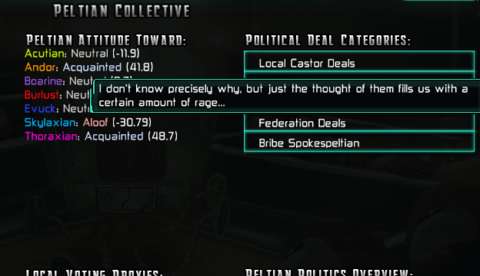
Unfortunately, holding onto any gains that the player has made with the Peltians can be difficult. Due to their terrible ground forces, they succumb quite easily to any invasion by physically powerful races, namely the Burlusts and the Thoraxians, both of whom dislike the Peltians because they seem weak.
BURLUSTS:
The Burlusts are the most aggressively antagonistic race; they are eager to fight anyone and will very much send navies and armies to the other planets just for the sake of waging war. Their aggression is also, for whatever reason, infectious; the Burlusts will spread hate among the other races as long as it has not joined the federation.
On the other hand, this can be exploited to the player’s advantage. The player can point them at an ascendant race that might need to be suppressed before it gets ideas of mono-species supremacy.
The Burlusts are one of a few races which have internal factions, though theirs are relatively simple. The Burlusts have three warlords which lead them, one of whom is the Prime Warlord. The Prime Warlord is the warlord that the player will need to approach if he/she wants the Burlusts to do anything as a race. The other two Warlords are there, just in case the player deems it convenient for one of them to usurp the throne, especially if the player has a lot of leverage over this one.
Speaking of leverage, the player will need to accumulate this over each individual warlord; leverage is accrued independently of Influence with the Burlusts. There are many ways to obtain leverage, but the ones with the highest return is having one Warlord gain advantage over another.
As befitting a race that is prone to warfare, one of the prerequisites for getting the Burlusts into the federation is to challenge the Prime Warlord to a duel to the death. This is easier said than done, because the Prime Warlord’s ship can single-handedly fill the battlefield with projectiles and it is incredibly tough (though it is also the slowest ship in the game).
In fact, killing the warlords is one of the quickest ways of accumulating influence with the Burlusts. However, there is a drawback to killing any Warlord: the Burlusts would go berserk, suddenly spawning additional armadas and armies from nowhere and sending them all over the planetary system to attack just about anyone else. The player will be unable to contact the Burlusts in any way for a while.
THORAXIANS:
The Thoraxians are aggressive too, but unlike the Burlusts, they have goals which are more sophisticated than wanton war. They have expansionist tendencies, which means that they are likely to attempt to invade and take over other planets, typically at the other races’ expense. The Thoraxians also multiply very quickly, making them incredibly difficult to exterminate.
The Thoraxians have hive minds, meaning that it is difficult to stoke rebellion among them (though the player could still somehow disrupt the communication between Thoraxians to foment infighting anyway). In negotiations with them, the player talks to their Queens. Initially, there is only one Queen, but there will be more if the Thoraxians manage to obtain more planets. The Queens are the only individuals of that race with any semblance of personality.
Speaking of personality, the Thoraxian Queen has frequent “mood swings”, to quote the game’s own words. To elaborate, at any one time, the Queen may be inclined towards a specific policy, such as increasing the population of the race, regardless of whether their planet is able to support any more population sustainably or not. Eventually, the Queen will switch to another set of policy, regardless of any factors affecting the race.
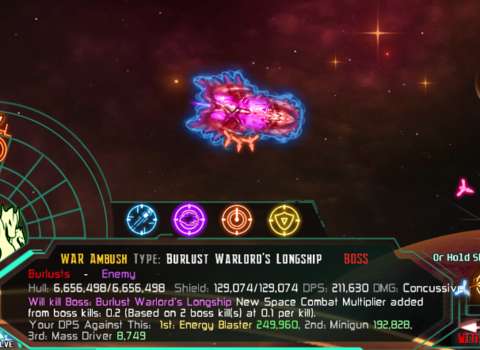
The player can accelerate this mood swings by giving the Queen gifts. The next mood is randomized, however, so at best this is only useful for having the Queen switch to another mood from an inconvenient one.
BOARINES:
The Boarines are one of the aforementioned opportunistic races. They are likely to declare war on another race that is in a weak position, but they will also quickly sue for peace once the tide turns. Their value to the player is their peculiar ability of bolstering the relationship between two other races, provided that the Boarines do not already despise them in the first place.
This makes the Boarines almost indispensable for players which want to get as many races into the federation as possible. However, the bribe items which are reliably attractive to the Boarines tend to be more expensive than the other items, so gaining influence with them is a costly endeavor.
EVUCKS:
The Evucks are another opportunistic race, though they are a lot more furtive and insular than the Boarines are. The Evucks specialize in making spy probes, which it will send to just about every other planet to watch the other races. This, of course, annoys the others. Destroying their spy probes is an easy way to curry favor with the other races, but at the expense of the player’s relationship with the Evucks.
The player can also make use of these spy probes by burning favors with the Evucks. The spy probes can somehow perform espionage and skullduggery against the other races, such as poisoning their water supplies. However, despite their furtiveness, the other races will know that the Evucks are responsible, and somehow know that the last Hydral is responsible too.
All of the races do not like doing favors for the last Hydral, but the Evucks are particularly so. Every time the Evucks do something for the player, their resentment accumulates, making subsequent requests costlier. The Evucks do not keep this resentment for long however; eventually, the premium on the cost of having them perform things will dissipate.
Perhaps the most unpleasant thing about the Evucks is that they know how to blow up the planetary system’s sun – something which they only do after they believe that they are threatened with extinction. The only way to stop the countdown to this certain game-over scenario is to complete their annihilation, or absorb them into the Federation.
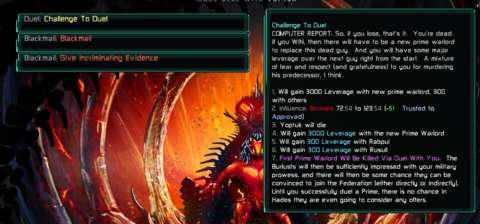
ACUTIANS:
Last but not least, there are the Acutians. Like the Andors, they are sentient machines, but where the Andors are adamant goody two-shoes, the Acutians are morally flexible, corporate-minded and industrious.
Gameplay-wise, this means that the Acutians’ politics are more complicated than the Andorians’. There are many internal factions in this race, which are based around economic fields. The factions that are in power determine the variety in the requests which the player can make of them. For example, trade deals are the purview of the transportation, communication and trade industries, so at least one of these must be in power so that the player can broker trade deals between the Acutians and the other races.
The Acutians’ most peculiar offering is their ability to attach rockets to moons and ram them into a planet; this happens to be exactly what they did to the Hydrals’ homeworld. This is something that they will not readily do, however, unless they particularly hate someone else (like they did the Hydrals). Of course, if a planet does not have any orbiting moons, they cannot do this.
INFLUENCE ON RACES & WHAT THE PLAYER CAN DO WITH IT:
As mentioned earlier, the player needs to curry favor with the races in order to have them do something for the player and vice versa. One of the ways – or rather, the requirements – to do this is to build relationships with them.
The player will need to build Influence with a race up to specific levels in order to make certain requests, and even to do something for them. For example, the player cannot help develop property for a race until he/she has obtained an Influence level of 25 with that race.
Influence is spent on almost any request which the player makes of any race, unless the request is something which they like to do. For example, most races resent lauding other races (even the ones which they like). As another example, the Burlusts would happily agree to requests to greatly increase their construction of armadas.
Gaining influence is as simple as doing something beneficial for a race. This can be done either via one-shot activities or long-running ones. An example of the former is the eradication of pirates, which all races appreciate. An example of the latter is assisting a race in the construction of armadas. (For whatever reason, helping a race build armadas yields more influence over time than other activities; this may have been intended for the purpose of gameplay balance.)
It is also easy to lose influence with any race, outside of making requests of them. Typically, doing things for the enemies of a race would upset it. Performing outright hostile acts, such as attacking the ships of that race, also reduces influence (greatly, in this case).
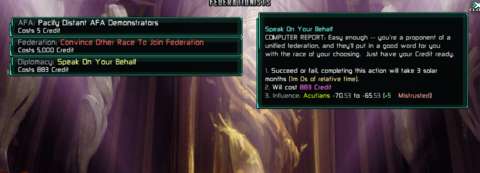
Having positive levels of influence with the races is a necessity if the player wants to utilize diplomacy to form a federation. There is generally no reason to have negative levels of influence, i.e. having the races particularly hate the last Hydral. However, negative levels for multiple races, especially if these levels were generated via hostile acts against these races, can help make them come together, if only to form an alliance against the player.
CREDITS:
In addition to Influence ratings with the races, the player will also need what the game terms “credits”. The game describes these as the resources, debts and other assets which are needed to carry out almost any activity, other than activities which already generate credits.
Gameplay-wise, it is yet another type of currency. Unlike Influence though, Credits are a currency that is not tied to any particular race. Credits cannot be lost in any way other than being spent on activities too. However, making requests of any race will require the expenditure of Influence on that race as well as Credits. Credits are also used at the Black Market to buy things and hire employees.
RELATIONSHIPS BETWEEN RACES:
In addition to balancing the player’s levels of Influence with the races, the player also needs to balance the relationships between the races. For better or worse, the game also uses the term “Influence” to describe the relationship between two races, though a determined player will eventually learn to differentiate between this kind of Influence and the previously described Influence.
Some of the races start every playthrough with animosity towards the others; this animosity is not necessarily mutual. For example, the Burlusts and Thoraxians do not like the Peltians because they perceive the latter as pathetically weak; although the Peltians are aware of this, they do not reciprocate on a one-to-one ratio. As another example, the Andorians do not like the Burlusts because they believe that the latter has no place in a peaceful galaxy (and they would be quite right), but the Burlusts could not care less about the Andorians’ ethos.
There are many ways for a race to change its opinion of another, either for better or worse. Furthermore, although the reasons behind these changes are understandable, the extent of the changes is not. Learning about them the hard way can be a little unpleasant.
For example, if a race is having poor levels of order on its planet, the other races will look down on it. This would have been understandable, but the poor level of order will continuously generate ill-will towards that race with no noticeable limit. It can seem absurd that other races would eventually go to war with this one over such a reason.
Generally, if the player is looking to include every race in the Federation, they will need to have good relationships with each other. Races with good relationships will not go to war, at least not without the player pulling a lot of strings. The only exception here is the Burlusts, who are happy to go to war with anyone else.
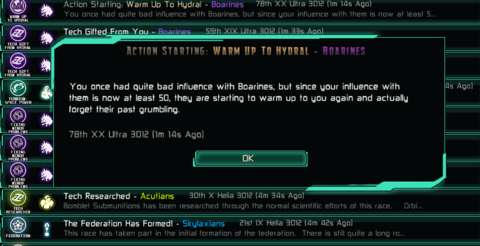
Speaking of war, this will sour relationships further if they were already bad enough to provoke wars. However, the races will eventually sue for peace after a while; even the Burlusts will eventually tire of fighting the same opponent.
One of the quickest ways to improve relationships between races is to have one race praise another race; this is one of the requests which the player can make of almost any race. This costs Influence with that race, but it is quite efficient, especially if that race has many friends.
With that said, that race will only laud another race to other races if that race likes that other race and the other races; a race will never sing praises about a race which it does not like, and will not sing praises about a race to races which it does not like.
A slow but very reliable way of fostering good relationships between races is to broker trade deals between them. Eventually, their trade will deepen to the point that war between them will be too costly. Of course, for the trade deals to occur, the two races need to already have resources which they can exchange. The resources which the races use will be described later.
They are many occasions which improve or worsen relationships between races, and many of them happen to be in the player’s control. The player will need to learn how to time their use, as well as accrue the resources, assets and prerequisites necessary to perform them.
SPACE-FARING ENDEAVOURS:
When a playthrough starts, only the race which had imprisoned the last Hydral and learned from it will have space-faring technology. Thus, they have a headstart on the other races – unless the player decides that the other races should become space-faring much earlier. After all, the first space-faring race will be hostile to the player, so interaction with it will be rather limited.
To give the other races space-faring capability, the player will need to drop off technological assets so that they can retrieve it. However, the other races which are already space-faring do not like this; they will somehow learn about the last Hydral’s intentions and scatter probes all over the drop-off area. These probes and their weapons are not exceedingly powerful, but there are often many of them (more of them will appear with each subsequent mission) and they fire many shots.
If a shot from a probe hits the player’s ship, it ‘detects’ the latter. For every probe which detected the latter, the player suffers losses in the relationship with that race which owns the probe. (The probe also becomes faster and shoots more projectiles.)
Gameplay-wise, this means that the player risks losing Influence which he/she has gained on the races which are already space-faring. Narrative-wise, this does not make much sense.
RESOURCES:
Being sentient beings with civilizations of sorts, the races need natural resources in order to prosper. The last Hydral, however, does not need any at all; the knowledge that it knows and the technology that it has render any need for resources moot. However, the last Hydral could help the races obtain resources or just gift resources to them so as to gain their favour.
The races mainly obtain resources from their planet, typically through mines and processing plants. If their planets have any moons, they can colonize these in order to tap their resources.
On the other hand, they do not have the means to colonize moons, regardless of how technologically advanced that they would become. Conveniently though, the last Hydral has the means to set up moon colonies for the races. This is a deed which the races appreciate, and the resources which the moons yield will help them greatly.
As for what they do with the resources, the races mainly use them in to build additional facilities on their planets; these facilities will be described later.
Alternatively, they can also build up surpluses of these resources, if they are not using them to establish facilities. They will eventually dig into these surpluses to build up one aspect of their planet. These aspects will be described further later, but it suffices to say for now that this is generally a positive thing for the race which started the endeavor.
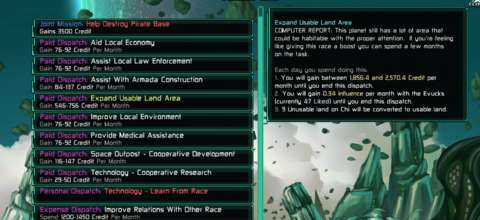
The races can also trade surpluses of resources for the surpluses of resources from other races. After all, there is no guarantee that a planet will have all types of resources, of which there are more than a dozen. (They are functionally the same, however.) More importantly, resource trades will eventually develop an interdependency between the races, making war between them much more difficult to happen.
ARMADAS:
After the races have obtained the technology to be space-faring, they will begin building armadas in order to project their power and also defend their planets from attacks from orbit.
When a planet builds armadas, it diverts some (or all) of its production capacity away from constructing facilities. Building armadas does not appear to consume resources however, so the costs are mainly opportunity costs.
The power of an armada greatly depends on the race’s technological level (specifically regarding space combat) and its natural aptitude. An armada that belongs to a race can be roped into a battle, generally through the player’s decisions. Its power in battle will be represented by the flagships which it fields. However, if the flagships are destroyed, that armada loses power and will field weaker ships in the next battle.
(This can be observed if the same armada joins the player as an allied armada in two consecutive battles and takes losses.)
With that said, the game does track the strength of every armada, but this information is not visible to the player; the player will not need this information anyway either.
Generally, if the player wants to interact with an armada, there are options which can be selected after the player’s ship has been stationed over a planet or on a space station with armadas orbiting them. However, there is also an option to specifically target armadas by clicking on them.
Considering that the icons for armadas can become rather numerous in the mid-game and late-game stages, this can lead to problems of user-friendliness. Fortunately, the option to click on armadas can be toggled off and on whenever the player wants to.
GOONS:
The races can field armadas, but the player cannot, or at least cannot field them and then use them like the races can. The most which the player can do is to hire security forces for the space stations which he/she controls; these security forces are called “goons” in-game.
Incidentally, goons tend to be a lot weaker than the ships which the races field. In fact, if the player wants to protect his/her space stations without directly engaging the attackers (which will worsen relations with the race which owns the armadas), he/she will have to hire many of them.
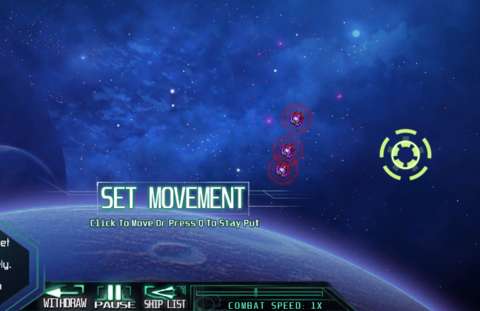
Fortunately, they are quite cheap to hire; more importantly, the expenditure of credits on them is one-time only, i.e. the player does not need to pay them salaries. On the other hand, goons which have been killed will not be replenished.
Furthermore, any goons which have been hired are somehow duplicated across all the player’s space stations. However, this also means that any damage which the goons take at one space station will be suffered at other space stations too.
TECHNOLOGY & RESEARCH:
The last Hydral already benefits from the pinnacle of technology and science which its race had developed earlier. However, the technology and knowledge that it has are not entirely applicable to the races. In fact, the races have to research and develop technology of their own, and these are not applicable to the Hydral either. Their progress can be tracked through a handy readout of the possible technologies which they can learn.
The technologies which the races can develop mainly increase their statistical performance. The effects are shown to the player in their tooltips.
The last Hydral can also learn these technologies, but they are useless to it. Instead, their value to the player lies in their use as bargaining chips or gifts. Alternatively, they can be used to buff up an ailing race. However, most of the other races will not like this, especially if they already have the technology which the player would give away.
Technologies regarding space combat do affect the player’s ship. However, their benefits only extend to the hitpoints and shields of the ship. As for the races, their level of space combat technology will determine how much damage that they can inflict.
This means that if the player does not make sure to keep up with the races, the races will eventually be able to reliably harm the player’s ship.
Fortunately, the player can learn technologies from the races if the player does not have them already. This can be done even if the player is on bad terms with them, for whatever discernible reason other than gameplay convenience.
Alternatively, the player can also research the technologies using the player’s own resources. This will be described later.
One of the ways to obtain technologies is to strike research pacts with the races. In this case, the race will contribute its research capacity to the endeavor. However, this is likely to annoy the other races.

RACE-SPECIFIC TECHNOLOGIES:
There are some technologies – if they can even be called that – which are only specific to certain races. The player cannot learn these, and these technologies cannot be shared with other races either.
The best examples of these are the evolutions which the Thoraxians can have. They can have enhanced exoskeletons, extra limbs and such other ugly modifications as befitting a race which sees their bodies as weapons.
SCIENTISTS:
In addition to goons, the player can hire scientists. These act as consumables which are expended when the player undertakes any research-related activities, be it learning from a race, actually doing research on one’s own or fulfilling a research pact.
Each scientist takes off one in-game month’s worth of research time. Research can take a long time, especially for higher-level technologies, so hiring some scientists to save time would be wise in the long run. However, scientists are expensive; they are twice as expensive as goons.
LOW RETURNS FROM MOST RESEARCH METHODS:
Ultimately, the most efficient way to learn new technologies is to learn them from races which have developed them. This is a process that happens quickly and there are no barriers to this; the player can even learn technologies from races which absolutely hate the last Hydral.
The other methods take too much time, at least not without a lot of scientific space stations to support the player’s efforts and a lot of scientists to burn. Both of these assets will consume considerable resources and time that could have gone to something else that is more fruitful, such as diplomatic efforts and activities which earn the player more credits.
FRIENDLY ACTIVITIES:
There are many activities which the player can perform for the benefit of the races or to inflict harm on them. These activities are categorized accordingly, the beneficial ones being labelled “friendly” activities.
Some friendly activities are not available if the player has not developed a positive relationship with a race, as mentioned earlier. Some others are always available, such as helping a race build armadas. These are not particularly profitable, but provide considerable Influence gain in order to compensate for their low credit gain.
Eventually, clever players will learn to juggle friendly activities with other needs, such as harvesting space junk in order to make some quick credits or propping up one aspect of a race’s civilization to allay a potential catastrophe. In the long run, doing this usually stabilizes the playthrough and sets it up for an endgame with a grand federation in the making.
It should be noted here that the player character’s contribution to any output of a planet is a flat bonus, The magnitude of the bonus depends on the player character’s own capability; it is not based on the planet’s existing conditions. For example, if the player helps a race with poor industrial output construct armadas, it would be cranking out armadas just a little slower than another race with higher industrial output would if it is being helped by the player. This is how considerable the player’s contribution is.
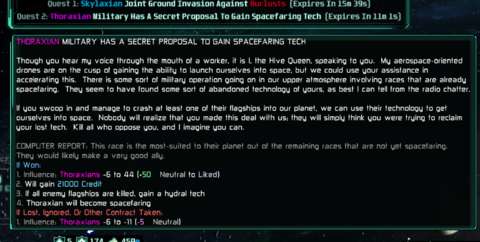
HOSTILE ACTIVITIES:
There are also hostile activities which a player can perform against a race. These are mainly intended to harm and destabilize a race, preferably one that is about to become ascendant at the expense of the others.
Unfortunately, their effects are too small to be used against races which are already strong. For example, the Thoraxians are often able to generate and maintain massive populations (and thus massive ground armies), so hostile activities which attack their population are not very useful.
(It may be more useful to damage the environment of the Thoraxians’ planet such that their population growth is affected, but this has a tendency to make them more likely to ingress upon other races’ planets.)
Furthermore, almost all hostile activities consume credits. This means that hostile activities are a lot more difficult to sustain and juggle than friendly ones.
The hostile activities which are perhaps useful are those that immediately create turmoil in the planet which they target. For example, the player could have leaders assassinated, which is particularly effective against races which do not have democratic practices. Of course, this will foment hatred towards the player.
DEMOCRATIC RACES:
The Peltians, Skylaxians, Andorians and, to a degree, Acutians and Evucks are races with democratic practices. Not having any leaders with concentrated authority means that they are harder to throw into turmoil, but the player can still meddle in their system of representation. In particular, with enough Influence, the player can have the Skylaxians undergo early elections, or shift Andorian representatives towards other stances.
These are the races which are the easiest to bring into the federation, especially if the player is resorting to diplomacy or guile.
PLANETARY CONDITIONS:
Every planet has ratings which the player might want to keep an eye on; these represent the conditions of the planet, which will be vital to the survival of the races.
Firstly, there is the planet’s economy rating. This determines the planet’s industrial output, which the owner would use to build either projects or armadas. Having a low rating will of course severely impact that planet’s development and defense.
Next, there is the planet’s compatibility rating with its owning race. If this rating is poor, it will suffer a penalty to just about everything it tries to do with this planet. This rating is difficult to improve, because it requires the completion of resource-intensive projects.
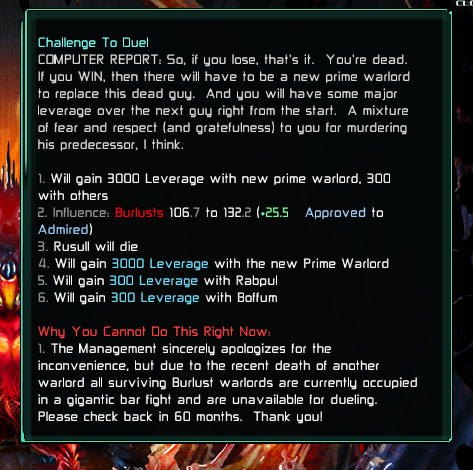
Interestingly, a planet also has compatibility ratings with other races. Moreover, the other races are well aware of these. These ratings can be a major incentive for the other races to attempt invasions of this planet. In more peaceful times, when harmony between races allow for migrations, these ratings will be a factor in the growth of expatriate populations.
Thirdly, there is the medical rating of the planet. This determines how fast its population grows and how resistant it is to plagues (which are random events which will be described later). The population of a planet also determines how strong its defensive army is.
Fourth, there is the order rating. This has a subtle impact on the productivity of a planet, among other ratings. However, its greatest impact is that low order ratings will cause other races to despise the owner of that planet, as mentioned earlier.
NOT-SO-RANDOM EVENTS:
There are some semi-random events which occur due to the ratings of a planet. They are likely to happen when the ratings of a planet have reached certain thresholds.
Having a low rating in most of the aforementioned conditions will lead to events which cause the exodus of a large portion of the population of that planet. This exodus typically leads to the creation of pirate lairs, which will cause both problems (namely piracy) and opportunities (namely the elimination of piracy, which every race appreciates).
Some of these events occur due to factors which are not immediately shown underneath the planet’s icon. Rather, they occur due to factors which can be examined by checking the planet’s detailed statistics. For example, there is a harmful event that would be triggered when the space junk around the orbit of a planet has become too thick (typically due to battles which are fought in orbit over the planet).
RANDOM EVENTS:
Next, there are completely random events. For example, a race might discover ancient (i.e. Hydral) technology on its planet, thus granting a technology unto that race without it having to do research first. As another example, a planet might be hit with a bizarre event which forces a downward trend in one of its aspects.
These can very much throw a spanner into the player’s plans, especially if the player is working towards uplifting a race or suppressing another.
QUESTS:
The races may hate the last Hydral, but they still have the gall to ask favours from it. This is mainly because the last Hydral can do many, many things that they cannot, and they know this.
Every once in a while, they will contact the player and offer quests. Quests are missions with specific objectives, though these are typically about destroying something (or somethings) or protecting something. If they are not these sundry objectives, then they would be about having the player’s ship reach somewhere.
Any competent player should not have a problem completing the objectives, though this also means that they are not particularly challenging either.
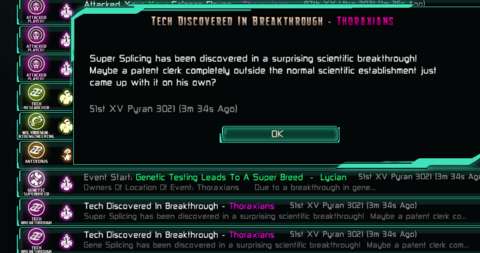
FEDERATION:
The “federation” has been mentioned several times before this. Although making a federation of planets is the main goal of any playthrough, the fundamentals of the gameplay would have to be explained before this overarching objective is described.
The player could have just a single race survive a playthrough, but to have any more races survive, a federation will be needed. To make a federation, the player first needs to get at least two races together.
This usually needs the two races to be on good terms with each other, but there may be other conditions. For example, to get the Burlusts into the federation, some other race needs to be militarily stronger than they are. (This can be difficult to achieve.) Conveniently, the conditions can be read in a screen that the player can bring up with the press of a button.
After the player has a federation formed, some additional gameplay elements will be introduced into the playthrough. These will be described shortly.
PRO-FEDERATION BENEFITS & DISADVANTAGES FROM FEDERATED RACES:
The races who have entered the Federation will begin to occasionally trigger the occurrence of special benefits. For example, the Andorians will produce waves of pro-federation inclinations across the planetary system, reducing the presence of anti-federation rebels and improving the opinions of races which have yet to join the federation.
Unfortunately, not every member of the federation brings something good to the table. For example, the Thoraxians, even if other races are on good terms with them and vice-versa, continue to scare the other races as long as they are within the federation.
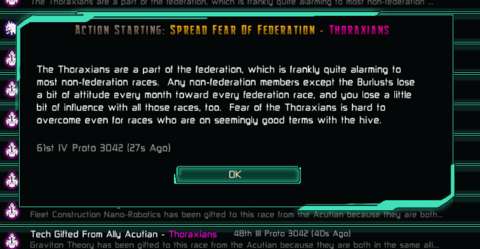
ANTI-FEDERATION ALLIANCE (AFA):
According to the narrative, the last Hydral attempts to keep a low profile during the founding of the Federation. This is because public knowledge of its involvement would torpedo its efforts, considering that the Hydrals were much hated.
Unfortunately, there will be people who very much suspect the Hydral’s (figurative) hand in this matter. Therefore, regardless of the benefits that the federation would bring, they will oppose the federation just because of the Hydral’s involvement. This opposition is represented in-game as the Anti-Federation Alliance, obviously the counter-movement to the federation.
Initially, the AFA is little more than malcontents among the races. However, if left alone, they will increase in number and eventually convert races entirely to the cause of the AFA. After this happens, these races become much more difficult to convince that the federation is worth joining. (There is a difficulty option which makes races permanently join the AFA, thus necessitating their elimination.)
Fortunately, there are ways to keep their numbers down – peacefully or violently (sometimes shockingly so). In the case of peaceful means, there are races which can provide diplomatic solutions to reduce their numbers, effectively returning these people back into the fold.
In the latter case, the elimination of the AFA rebels is for the player to perform alone, because the rulership/leadership of the races generally do not want to move against their own people.
Conveniently, the AFA rebels are, for whatever reason, mostly in space stations that are in orbit around their home planet. Therefore, they can be killed by destroying these space stations. This is easier said than done, because the space stations are heavily ringed with powerful static defenses (likely because the rebels are aware that the last Hydral might just come after them).
The possibly unpleasant part here is that the space stations often house hundreds of thousands of rebels, which do contribute to the population of the planet. The player could be effectively depopulating the planet by eliminating them, which in turn renders it vulnerable to invasion. Attempts to repopulate it afterwards might not work either, especially if there is an event which causes anti-federation sentiments to run high. (These events begin to occur after the player has formed a federation.)
Furthermore, blowing up these space stations and their defenses will contribute to the space junk around the orbit of the planet. If the player has to repeatedly eliminate rebels at the same planet, there can be an unmanageable build-up of space junk.
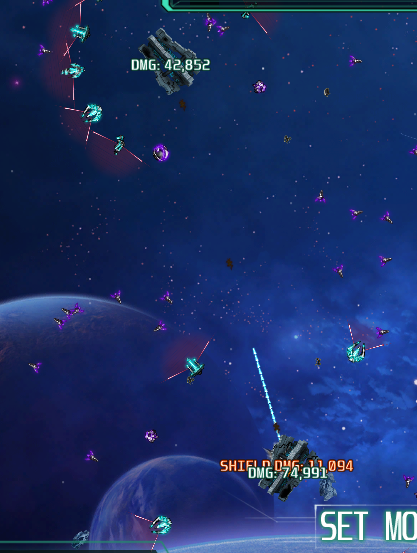
VISUAL DESIGNS – FOREWORD:
If one has played many of Arcen Games’ titles, one might make the observation that one of their perennial flaws is their presentation. Unfortunately, The Last Federation is not an exception.
Fortunately, compared to Arcen’s previous games, the art direction in The Last Federation keeps the gameplay more in mind, at least most of the time. Examples of where this occurs – and where it does not – would be described in the following sections.
VISUAL DESIGNS OF SHIPS:
Firstly, there is the matter of the appearance of the ships. They look very much like an extension of what has been done for A.I. War, which has hideously ugly sprites for units. On the other hand, the ships in this game better resemble typical sci-fi space-ships than those in A.I. War, e.g. they appear to have fuselages as to be expected of space vessels, rather than resembling cockroaches.
Fortunately, there is at least the size of the ships, which helps in differentiating flagships from the smaller, less significant vessels. Even so, there are a few ships which have the firepower of flagships but have the size of smaller vessels.
VISUAL DESIGNS OF PROJECTILES:
It has been mentioned already that the game has some elements of bullet hell shooters. This can be seen from the gamut of projectiles that would fill the screen during battle.
The player should not expect the projectiles to have visual designs which contribute to gameplay, however. Supposedly, there are projectiles which inflict more damage on either shields or hulls than the other, but there is no common colour or shape which can be used as a reliable indicator of which projectiles hurt which more. Rather, the speed of the projectiles is a better indicator; anything that is slow is likely to be particularly painful if it hits the player’s ship.
ARTWORK FOR RACES:
Arcen’s artists have invested some effort into making sure that each of the races look different, but their output is little more than what can pass as conceptual and miscellaneous artwork. This is only seen when the player brings up the diplomacy or action screens.
There is some attempt to differentiate the ships of the different races, but the designs of the ships belonging to any race do not appear to have any common detail. Therefore, the act of identifying the race which a ship belongs to has to be done by checking their tooltips.
WRITING & VOICE-OVERS:
The writing and voice-overs are perhaps the least well-done aspects of the game, especially when they try to go hand-in-hand.
Firstly, there is the narration by the last Hydral. It can be odd to listen to what is supposed to be a thousands-years-old creature talk in an informal manner with a coastal USA accent as it describes what has happened to its race and its intention to form a federation.
The worst voice-overs are those for the on-board A.I. of the player’s ship. It can come off as rather annoying, especially considering that it imparts little useful information but talks a lot anyway.
As for the text, there is the mistake of mixing flavour text with gameplay-relevant text. For example, there is a screenshot in this review article which describes what happens when the player kills a Burlust warlord. Of course, thorough reading is a work-around for this, but this would not have been necessary if there has not been such mixing.
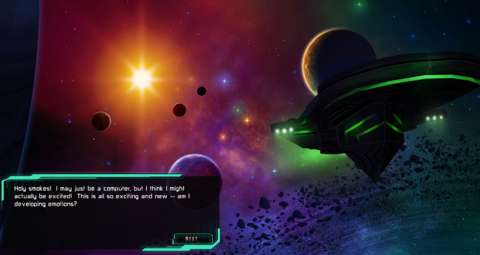
SOUND EFFECTS:
Arcen Games had a bad habit of recycling its sound assets. Fortunately, this is not so for The Last Federation. That is not to say that the sound effects are original; they may well have been remixed from publicly available sound-clip stocks. Nevertheless, they are not jarring and fit the sci-fi setting as sound-clips for sci-fi settings ever could.
MUSIC:
The Vega couple are again the composers of the music for this Arcen Games title. As to be expected of them, they have composed tracks that do not exactly match the theme and setting of the game. There are melancholic tracks alongside ominous ones, and these play at times outside of combat. When the player is thrust into what passes as space battles in this game, there are more upbeat tracks to be heard.
Interestingly, there is noticeably little use of clearly electronic music, and considerable use of instrumental ones. This is actually a pleasant change, especially considering the mostly unpleasant music in Bionic Dues (which is Arcen Games’ previous title).
SUMMARY:
The Last Federation is game with considerable complexity which belies its seemingly crude appearance. It is a game about juggling relations between factions which are not always inclined to seek mutual prosperity, and it is also about a different take on bullet-hell shooters, in which the player’s vehicle is the most powerful war machine around. In other words, like Arcen Games’ previous titles, The Last Federation is a very peculiar game that just might appeal to players who want something different – assuming that they can cope with the density of its gameplay.
